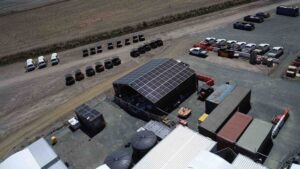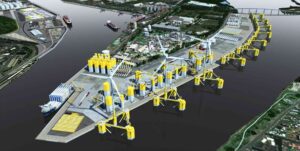There is no hiding from the fact the global economy must transition to net zero, and the faster Australia gets on board – starting with 100 per cent renewable energy – the better for the economy. The more it lags behind, the more likely the country is to fall into the economic doldrums.
But in the process of greening the economy, investors will have to negotiate a radically changed investment world, and picking winners will be extremely difficult, raising the likelihood of a dot-com style bubble.
Those were some of the central points in a speech by Chris Iggo, chief investment officer of core investments at AXA IM, one of the largest fund managers in the world.
Speaking to a conference in Sydney on Wednesday, he said without a rapid transition to renewably-generated power, economic growth would stall and businesses would fail.
“If you are a carbon emitter, you are increasingly paying a higher cost for that,” Iggo said. “The scope of companies and activities affected is growing, and continuing with the status quo is becoming uneconomic.”
He said industries such as travel and tourism, agriculture, infrastructure and forestry were particularly at risk, all of which were important sectors in Australia (he didn’t mention coal and gas exporters or fossil fuel energy generators, for some reason).
For sun-, wind- and land-rich Australia, he said the answer was obvious: 100 per cent renewable energy.
“This could be a great long story for Australia and some emerging market countries which are renewable energy-rich. A full transition to renewable energy could really transform these economies and also significantly increase their political power on the global stage.”
In this, the London-based economist, banker and bond investor is wholly on board with the clean energy “superpower” vision painted by prominent Australian economist Ross Garnaut.
But Iggo added a note of caution to investors who think anything with the word “renewable” in it has boundless growth potential.
“The cost of renewable energy is falling massively. There are opportunities to invest in the new technology and the companies developing the new processes. There is growth in strategies that are available now to invest in the transition.
“However, investors need to think about sustainability – that is, picking business models that will be successful over the long term. Companies focused on the transitioning are likely to achieve earnings comparable to what the digital companies have generated for the last 30 years. But not every company will be a winner. It will be about picking the Apples or Googles of a very different future.”
The renewable energy transition, and decarbonisation of economies more generally, is the big new theme in the investment world. European investors like the France’s AXA, Germany’s Allianz, and the UK’s Aberdeen Standard Investments, are now using the sort of language that a decade ago you would have expected in the mouth of a Greenpeace activist, not a City of London financier.
US investment giants have been slower to come around, but that is rapidly changing, as shown by BlackRock boss Larry Fink’s green conversion. BlackRock is far and away the biggest fund manager in the world, with a staggering $US8.7 trillion of assets under management, dwarfing AXA’s €555 billion ($US670 billion), which still puts AXA in the top 20.
Solar panels, wind turbines, batteries, electric vehicles, and the minerals that build them – copper especially – are suddenly the most exciting things to invest in. Tesla’s stratospheric share price rise last year – it went from $88 to $880 over the course of the year – is an example of this. But there are obvious parallels with the dot-com bubble in the late 1990s, when investors piled into tech stocks and pushed their valuations to absurd levels until the whole thing came crashing back to reality in 2000. Iggo is not the only one talking about this risk.
Last week Nicolai Tangen, the head of Norway’s $US1.3 trillion Oil Fund, the world’s largest sovereign wealth fund, drew the same comparison. But he said it was not necessarily cause for major concern. In fact, he said if there was a green bubble, it would likely be an overly exuberant response to a genuine revolution, just as the dot-com bubble was.
“What is interesting is, if you compare the situation now with, for example, the situation before the year 2000, then the stock market was right that technology companies were going to do well in the future,” Tangen told Bloomberg. “But the valuation went a little high, so it came down again, but the technological development continued.”










